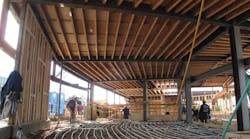By Lisa Murton Beets
An all-in-one hydronic heating and cooling package sounds perfect when your mechanical room is so small that the pool room dwarfs it in comparison — doesn’t it?
That was the case on this recent new construction project in Pacific Palisades, an affluent coastal community west of Los Angeles.
The 8,500-sq.ft. structural concrete and timber-framed luxury home overlooks Malibu and Santa Monica Bay. Bill Shady, P.E., owner of Sustainable Design & Product Management LLC (SDPM), served as mechanical engineer of record and worked with the plumbing engineer to complete the design of the HVAC and plumbing systems. Shady designed and specified Climate Right Systems for the project. The plug-and-play appliance was installed by Yantzer Brothers Air, Westlake Village, Calif., under a subcontract with the general contractor, Jim Schram of Winters-Schram Associates, based in Los Angeles.
Jim Schram originally heard about Climate Right Systems through an architect associate and then again from mechanical contractor Steve Yantzer.
“Jim called me to a client meeting where they expressed their interest in a combined renewable energy integrated hydronic system,” Shady says. “We talked about past projects, and they decided that is what they wanted for their home.”
As Shady explains, the “Right” in the product name stands for Renewable Integrated Gas Hybrid Thermal Systems. “This system did what they wanted all in one package; it would arrive at the jobsite already built and tested at the factory, with no need to fabricate on site.
“We were coming out of two years of prototype and product testing and into mass production,” Shady continues. “During this project, we were able to hone the assembly 3D model so that fabrication now takes days instead of weeks.”
“It’s a completely engineered, assembled, and functional-tested heating and cooling appliance/package that uses water as a means to heat and cool,” he says. “It can heat and cool the building, provide domestic hot water and hot water recirculation, and can use waste heat for swimming pool and spa heating. It can be configured for solar thermal assist, combined heat, and power systems such as stationary PEM fuel cell heat output, and contains all the necessary controls for the project.”
Shady adds that the product can take the heated and chilled water from any source, including all forms of heat pumps, air-cooled, geothermal, absorption, or natural gas-fired equipment. “We end up being the heart and the brains of the mechanical system, which most importantly includes the controls for the entire HVAC system in the building.”
Project Specifics
Climate Right Systems was a great choice for the Pacific Palisades project. Mechanical rooms in this locale are very small because each square foot of space comes at such a premium. “The pool room got more space than we did,” Shady comments. “By fitting a small footprint mechanical package into the pool equipment room, the interior mechanical areas became useable, livable space.
“Because we know the dimensions and location of every utility from DHW, heating hot water, gas, electric, and chilled water, we provide a drawing to the contractor with specific locations,” Shady adds. “During rough-in, all of the trades use one coordinated drawing, saving them all the headaches of jockeying for space and access in the compact mechanical rooms.”
The two-level home was designed by the architectural firm Studio Pali Feketa (SPF:a). It features radiant floor space heating, solar-assisted domestic hot water, heat recovery ventilation, and mechanical air-conditioning designed to work in tandem with prevailing coastal breezes.
Designed for indoor/outdoor living, the home has high-mass concrete floors and walls, and a low-mass, fast-responding hardwood floor — a perfect application for radiant.
The ground level (below-grade living space) features a family room, wine cellar, bar, gym, and bed/bath combinations. It opens up to an outdoor courtyard area. The space heating for this level is embedded structural slab with Uponor ½-in. PEX, 9-in. O.C., in multiple zones. The flooring is all exposed, polished concrete.
For the upper floor, which consists of the main living area and bed/bath combinations, Shady specified ¾-in. Ecowarm low-mass thermal subfloor with ½-in. PEX 12-in. O.C. to overlay on top of suspended structural slab to match finished floor heights. Floor coverings included hardwoods, finished concrete stone, and tile.
The owner chose not to install mechanical air-conditioning in the ground level. This level is, however, equipped with a Carrier heat recovery ventilator for continuous year-round ventilation, including continuous exhaust at low speed in the bathrooms.
The mechanical air-conditioning for the upper floor was selected and sized for low velocity and noise. Shady had to take into account innovative architectural features that include entire wall sections open to prevailing coastal breezes during mild ambient conditions. When outside air is too hot, the air-conditioning cools key areas.
Due to a local ordinance prohibiting outdoor air-conditioning equipment in side setbacks, the air-cooled Carrier DX condensing units were placed in a below-grade mechanical room. Condenser air comes down a shaft originally designed for boiler flues, but was repurposed for the air-conditioning system. Two condensing units fit, but there was no room for a necessary third.
“So we put a Carrier water-source heat pump in the pool room,” Shady explains. “It unloads heat from the space into the pool. The pool isn’t huge, so when the pool water reaches a high limit of 85°F, relays enable the infinite edge filter pump to cascade into a lower well and by evaporative cooling, help to air condition the house.”
“So it functions kind of like a cooling tower?” one young architect from design firm SPF:a Architects recently asked Shady during a presentation on the system in their offices.
“No, like a ‘pooling’ tower,” Shady joked.
The pool itself is cantilevered over a wall, Shady explains. “The structural engineer imposed limitations on embedding radiant tubing in the pool shell (as a means to provide excess solar heating for the pool with very low energy input). We ended up installing a smaller (than originally envisioned) solar thermal array, accepting that we could not make the pool a heat sink. The solar thermal array provides heat energy for domestic hot water and radiant space heating. If there is minimal demand for water or space heating, the expansion tank is sized to accept fluid pushed out of the collectors.”
Other features of the Climate Right Systems that Shady designed and fabricated for this project (each job gets an individually tailored system) are as follows:
Domestic hot water is solar-assisted by two HTP 119-gal. SSC-119SB storage tanks with a Lochinvar Knight WHN-199 natural gas-fired condensing boiler; it also includes a recycled HTP Munchkin (that the owner had purchased for a former home) to
back up the Lohinvar 1½-in. high-volume domestic hot water service with Watts N170 high-efficiency mixing valve. Domestic hot water recirculation is provided by a Grundfos stainless-steel, multi-speed circulator. Radiant floor heating circuits are served by a single Wilo Stratos constant pressure variable speed circulator. One pump does the whole house heating demand. Air-conditioning, radiant heating zone, solar, and stored solar/hot water controls are all prewired and tested at the factory. Brands installed are Carrier, Lochinvar, Heat Transfer Products, Taco, Tekmar, Goldline, and Thermomax.
“The controls all do their own jobs, but they do not communicate, nor is there a central point to view, monitor, or validate the overall system performance. That is why we recommend the move to Direct Digital Controls (DDC),” Shady says.
More Control Features
While the controls for this particular job are not digital (the homeowner nixed digital controls for budgetary reasons), Shady does design DDC into other Climate Right Systems. In fact, he says, they’re almost a necessity for commercial and multi-unit projects. “Digital controls are the way to go; they let us know in advance if the system is experiencing problems, and how the system has been behaving in the past.
“At the time we developed this model, we had yet to formalize a relationship with a DDC controls platform,” he continues. “The cost differential between digital and non-digital has come down significantly now that we are committed to the open-source and BACnet Delta Controls platform, as well as the Uponor Climate Control Network (CCN), an OEM product made for Uponor by Delta.
“The digital controls have tremendous diagnostic and validation capabilities and user-friendly graphics,” Shady continues. “For example, imagine the happy client who gets a call from the service contractor who is coming out to replace the snowmelt system circulator before the client even knows it’s an issue. The contractor got the alarm, called up the system, saw immediately where the problem was, got the parts, and drove out to the client site with the solution. That is the ultimate in
customer service.”
How did Yantzer Brothers Air like installing the Climate Right Systems? “It’s a very user-friendly product — a pleasure to put in,” says owner Steve Yantzer. “It’s an impressive system, both mechanically and visually. Bill was there to work out all the nuances, but it was a pretty seamless install. We’ll be installing another model of the Climate Right Systems in another project soon.”
According to Shady, the Climate Right Systems give plumbers and HVAC mechanical contractors the opportunity to break into the renewable hydronic heating/radiant market without the steep learning curve. “Now they can offer solar thermal and hydronic heating/cooling as well.” He’s currently working with a handful of other consulting mechanical engineers and mechanical contractors who are specifying Climate Right Systems as an appliance, and is always willing to talk to others who may be interested.
For more information, visit his website at www.sustainabledesignpm.com.
Lisa Murton Beets is a Cleveland-based freelance writer and frequent contributor to Radiant Living.



